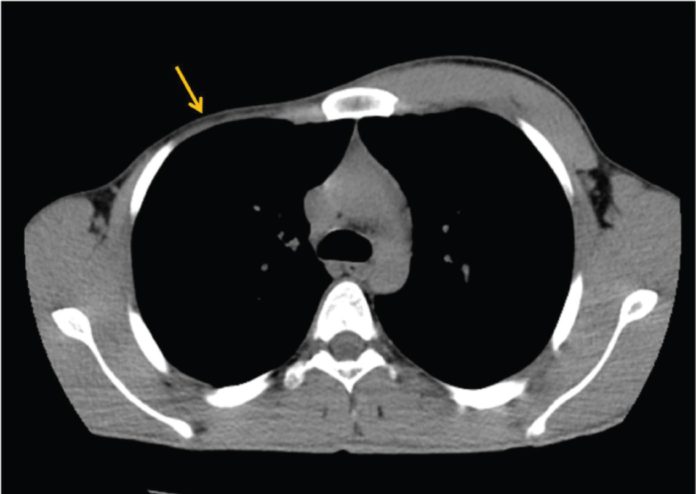A rare congenital disease in a 20-year-old male with asymmetric chest and limb defects
A 20-year-old man presented to the hospital with an asymmetrical appearance of the right chest wall. On physical examination, the right chest wall was asymmetrical, with a hypoplastic right nipple. His right-hand examination revealed syndactyly between third and fourth fingers. The doctors suspected Poland syndrome.
They performed a computed tomography scan of the chest, demonstrating the absence of the right pectoralis major muscle. However, the CT scan revealed no bone anomalies.
Poland syndrome
Poland syndrome is a rare congenital disorder characterized by unilateral absence (aplasia) of chest wall muscles (pectoralis muscles). Moreover, the affected individuals also have ipsilateral limb defects, including abnormal short, webbed fingers (symbrachydactyly) of the hand on the same side (ipsilateral). Affected individuals may also suffer from mammary hypoplasia and other muscle and bone abnormalities
The affected individuals have underdeveloped or absent muscles on one side of the body. The syndrome may affect the chest, shoulder, arm, and hand. However, the severity and extent of the abnormalities differ from person to person.
The exact cause of PS is unknown; however, there some probable theories regarding the aetiology, including disrupted development of the subclavian artery, defective migration of fetal mesodermal tissue, and intrauterine insults.
Affected patients with PS may present at birth if there is severe disconfiguration of the thoracic cavity and upper extremity may be detected at birth. In contrast, mild asymmetry may present later on in life, usually around puberty, as it mildly affects the thoracic wall and the breasts. However, the asymmetry becomes more evident at puberty, hence leads to the diagnosis.
It is imperative to further evaluate the affected individuals for other internal abnormalities because, in rare cases of severe Poland syndrome, individuals may also have anomalies of the internal organs including dextrocardia, and other anomalies involving the lungs or kidneys.
References:
Erdogan H, Oncu F, Arslan FZ, Durmaz MS, Arslan S, et al. (2018) Pectoralis Muscle Aplasia in Poland Syndrome. Clin Med Img Lib 4:091. doi.org/10.23937/2474-3682/1510091
Poland syndrome: https://www.annalsthoracicsurgery.org/article/S0003-4975(02)04161-9/pdf




